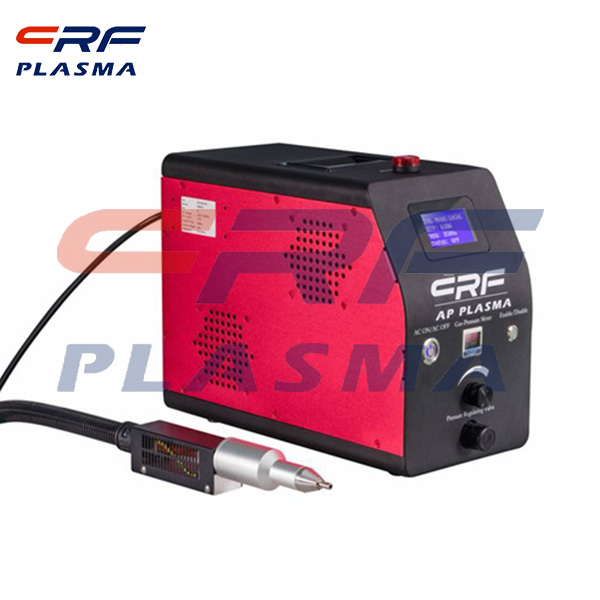
Welcome to Shenzhen Sing Fung Intelligent Manufacturing Co., Ltd.
E-mail:shaobo@sfi-crf.com
Plasma pulse etching technology of plasma cleaning machine
- Categories:Industry News
- Author:plasma cleaning machine-surface treatment equipment-CRF plasma machine-Sing Fung Intelligent Manufacturing
- Origin:
- Time of issue:2020-11-28
- Views:
(Summary description)In the traditional sense, the plasma etching process of plasma cleaning machine needs to achieve high yield, high uniformity, high selection ratio, anisotropy and no damage, etc. Etching process yield is a measure of productivity. It refers to the number of wafers etched per unit of time. Another important quality-related indicator is the etching uniformity within and between wafers. The required etching uniformity is the guarantee of chip yield. For the etching anisotropy of plasma cleaning machine, it directly defines the profile of the side wall of the etched microstructure. The potential plasma-induced damage (PID) has a significant impact on the performance of the device. For conventional continuous plasma etching, it becomes more and more difficult to achieve the etching target when the device size is reduced to below 14nm node. In order to meet these challenges, plasma pulse etching technology of plasma cleaning machine has been developed and gradually applied in industry. Plasma pulsed technology was reported in the late 1980s and used for basic research in plasma physics. It is found that the pulsed plasma etching technology can solve many problems of the traditional continuous plasma etching, especially for the etching process with negative plasma. Compared with traditional continuous plasma etching, plasma pulsing technology of plasma cleaning machine can achieve etching process with high selectivity, high anisotropy and light charge accumulation damage, and can improve etching rate, reduce polymer production, increase etching uniformity and reduce uv radiation damage. In order to better understand the relationship between input parameters (control variables) and output results (etching results) of plasma pulse etching technique. Different input parameters, such as reactor structure, Source and Bias power, air pressure and Frequency, gas flow rate and composition, material and cavity wall temperature, Pulse method (Source only, Bias, only, Synchronous Pulsing), Pulse Frequency, Pulse Repetition Frequency, PRF), Pulse Duty ratio (Pulse Duty Cycle) and Pulse Phase ((Phase Difference), etc., will affect the plasma characteristics in the reactor, Such as plasma density, reactive group activity, electron temperature, ion flux and energy, neutral particle and ion flux ratio, and dissociation rate. By changing the plasma characteristics of the plasma cleaning machine to affect the output results, such as cavity side wall state, macroscopic etching non-uniformity, etching and polymer deposition, microscopic etching non-uniformity, vertical and horizontal etching, graphic side wall protection layer, key size, side distortion and plasma-induced damage. Optimize etching results by regulating important plasma properties by regulating chemical and physical reactions occurring inside the plasma and on the wafer surface. To better control these plasma characteristics, this is typically achieved by controlling the electron energy distribution (EED) and the ion energy distribution (IED), because the distribution of electrons and ions greatly affects the rate at which the ions and wafers react. In a general sense, the plasma cleaning machine electrons affect the excitation, ionization, decomposition and thermal diffusion processes, thus affecting the flux, energy and surface reaction rate of many neutral reaction groups. Ions can transmit enough energy to promote the surface chemical reaction process and induce sputtering, thus affecting the flux and energy of reactive ions as well as the surface reaction rate involved by ions.
Plasma pulse etching technology of plasma cleaning machine
(Summary description)In the traditional sense, the plasma etching process of plasma cleaning machine needs to achieve high yield, high uniformity, high selection ratio, anisotropy and no damage, etc. Etching process yield is a measure of productivity. It refers to the number of wafers etched per unit of time. Another important quality-related indicator is the etching uniformity within and between wafers. The required etching uniformity is the guarantee of chip yield. For the etching anisotropy of plasma cleaning machine, it directly defines the profile of the side wall of the etched microstructure. The potential plasma-induced damage (PID) has a significant impact on the performance of the device. For conventional continuous plasma etching, it becomes more and more difficult to achieve the etching target when the device size is reduced to below 14nm node. In order to meet these challenges, plasma pulse etching technology of plasma cleaning machine has been developed and gradually applied in industry.
Plasma pulsed technology was reported in the late 1980s and used for basic research in plasma physics. It is found that the pulsed plasma etching technology can solve many problems of the traditional continuous plasma etching, especially for the etching process with negative plasma. Compared with traditional continuous plasma etching, plasma pulsing technology of plasma cleaning machine can achieve etching process with high selectivity, high anisotropy and light charge accumulation damage, and can improve etching rate, reduce polymer production, increase etching uniformity and reduce uv radiation damage.
In order to better understand the relationship between input parameters (control variables) and output results (etching results) of plasma pulse etching technique. Different input parameters, such as reactor structure, Source and Bias power, air pressure and Frequency, gas flow rate and composition, material and cavity wall temperature, Pulse method (Source only, Bias, only, Synchronous Pulsing), Pulse Frequency, Pulse Repetition Frequency, PRF), Pulse Duty ratio (Pulse Duty Cycle) and Pulse Phase ((Phase Difference), etc., will affect the plasma characteristics in the reactor, Such as plasma density, reactive group activity, electron temperature, ion flux and energy, neutral particle and ion flux ratio, and dissociation rate. By changing the plasma characteristics of the plasma cleaning machine to affect the output results, such as cavity side wall state, macroscopic etching non-uniformity, etching and polymer deposition, microscopic etching non-uniformity, vertical and horizontal etching, graphic side wall protection layer, key size, side distortion and plasma-induced damage.
Optimize etching results by regulating important plasma properties by regulating chemical and physical reactions occurring inside the plasma and on the wafer surface. To better control these plasma characteristics, this is typically achieved by controlling the electron energy distribution (EED) and the ion energy distribution (IED), because the distribution of electrons and ions greatly affects the rate at which the ions and wafers react. In a general sense, the plasma cleaning machine electrons affect the excitation, ionization, decomposition and thermal diffusion processes, thus affecting the flux, energy and surface reaction rate of many neutral reaction groups. Ions can transmit enough energy to promote the surface chemical reaction process and induce sputtering, thus affecting the flux and energy of reactive ions as well as the surface reaction rate involved by ions.
- Categories:Industry News
- Author:plasma cleaning machine-surface treatment equipment-CRF plasma machine-Sing Fung Intelligent Manufacturing
- Origin:
- Time of issue:2020-11-28 09:29
- Views:
Plasma pulse etching technology of plasma cleaning machine:
In the traditional sense, the plasma etching process of plasma cleaning machine needs to achieve high yield, high uniformity, high selection ratio, anisotropy and no damage, etc. Etching process yield is a measure of productivity. It refers to the number of wafers etched per unit of time. Another important quality-related indicator is the etching uniformity within and between wafers. The required etching uniformity is the guarantee of chip yield. For the etching anisotropy of plasma cleaning machine, it directly defines the profile of the side wall of the etched microstructure. The potential plasma-induced damage (PID) has a significant impact on the performance of the device. For conventional continuous plasma etching, it becomes more and more difficult to achieve the etching target when the device size is reduced to below 14nm node. In order to meet these challenges, plasma pulse etching technology of plasma cleaning machine has been developed and gradually applied in industry.
Plasma pulsed technology was reported in the late 1980s and used for basic research in plasma physics. It is found that the pulsed plasma etching technology can solve many problems of the traditional continuous plasma etching, especially for the etching process with negative plasma. Compared with traditional continuous plasma etching, plasma pulsing technology of plasma cleaning machine can achieve etching process with high selectivity, high anisotropy and light charge accumulation damage, and can improve etching rate, reduce polymer production, increase etching uniformity and reduce uv radiation damage.
In order to better understand the relationship between input parameters (control variables) and output results (etching results) of plasma pulse etching technique. Different input parameters, such as reactor structure, Source and Bias power, air pressure and Frequency, gas flow rate and composition, material and cavity wall temperature, Pulse method (Source only, Bias, only, Synchronous Pulsing), Pulse Frequency, Pulse Repetition Frequency, PRF), Pulse Duty ratio (Pulse Duty Cycle) and Pulse Phase ((Phase Difference), etc., will affect the plasma characteristics in the reactor, Such as plasma density, reactive group activity, electron temperature, ion flux and energy, neutral particle and ion flux ratio, and dissociation rate. By changing the plasma characteristics of the plasma cleaning machine to affect the output results, such as cavity side wall state, macroscopic etching non-uniformity, etching and polymer deposition, microscopic etching non-uniformity, vertical and horizontal etching, graphic side wall protection layer, key size, side distortion and plasma-induced damage.
Optimize etching results by regulating important plasma properties by regulating chemical and physical reactions occurring inside the plasma and on the wafer surface. To better control these plasma characteristics, this is typically achieved by controlling the electron energy distribution (EED) and the ion energy distribution (IED), because the distribution of electrons and ions greatly affects the rate at which the ions and wafers react. In a general sense, the plasma cleaning machine electrons affect the excitation, ionization, decomposition and thermal diffusion processes, thus affecting the flux, energy and surface reaction rate of many neutral reaction groups. Ions can transmit enough energy to promote the surface chemical reaction process and induce sputtering, thus affecting the flux and energy of reactive ions as well as the surface reaction rate involved by ions.

Scan the QR code to read on your phone

TEL:0755-3367 3020 / 0755-3367 3019

E-mail:sales-sfi@sfi-crf.com

ADD:Mabao Industrial Zone, Huangpu, Baoan District, Shenzhen


















